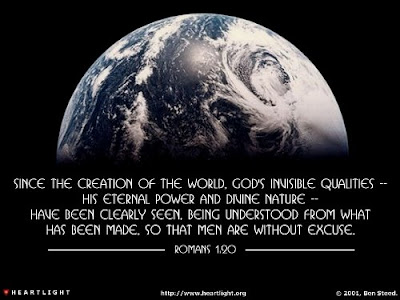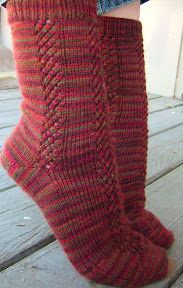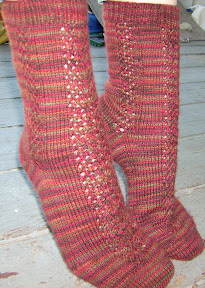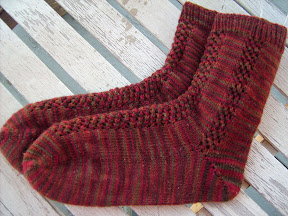I have developed a new technique that will revolutionize the world of sock knitting making it possible for even babies to knit. It requires no needles and you merely have to THINK the pattern in order to knit a sock. I call it Think Knitting.
If you don’t realize that this is April Fool’s Day by now, then April Fool. But if you have been anywhere on the internet, you probably already realized it. I hope you have all had as much fun as I have checking out the pranks all over the web. Ravelry has been especially festive with all the hats, parrots, monkeys and various other fun stuff.
But seriously folks, I do have some socks to share with you. These I knitted for SmallFry.

And I do have a different take, at least for me, on the traditional, top down heel when knitting two socks at once on circular needles. I have had an on-again-off-again relationship with circular needles for sock knitting. I liked the portability as well as the ability to knit both socks at once but I hated, detested, despised knitting heels on circulars. All of the instructions I have found are the same, whether for one circular or two. Knit one heel completely and then knit the other heel. Somehow, I always ended up having to reposition stitches somewhere along the line. I have always found this method awkward and frustrating especially with my preferred 32 inch needle length. I normally resorted to working the heel on dpns or using a dpn to pick up the gusset stitches. The process was just too awkward otherwise. However, this is just not an ideal situation for obvious reasons.
But before I totally tossed the circular method, I decided to try something different, something I hadn’t stumbled upon before. The worse that could happen was that I would have to frog the heels and reknit them on dpns, right? Surprisingly, I found that my method worked much better for me for heels on circulars. I didn’t even have to use a dpn once to complete a both heels. I finished the pair for SmallFry in record time. Just in case this was some sort of fluke, I tried the same technique on the socks I was knitting for Preteena. Again, I found the technique a faster, less frustrating method for knitting heels on circular needles. Since I have not seen this method posted anywhere else, I thought you might benefit from my “discover” too (my apologies to whoever might have thought of this before me – someone probably has).

Simultaneous Circular Heels
I have always questioned why it was necessary to knit one heel at a time when knitting two socks on circulars. There didn’t seem to be anything other then the actual heel turn that wouldn’t work together so here is what I tried.
Set up
When you are working on circulars all your heel stitches are generally on the back needle and all the top-of-foot stitches are on the front needle (or on the front and back of the same needle when using Magic Loop). Complete the last row of the leg at the point where you will begin the heel. DO NOT TURN! For clarity, when looking at the sock after the completion of this last round, the sock that is currently on the right will be referred to as the First sock and the sock currently on the left will be referred to as the Second sock. This naming will continue regardless of the actual orientation of the socks. If you like, you can mark the First sock (the one currently on the right) with a split ring stitch marker, a loop of contrasting yarn or some other method. This sounds confusing when writing it down but I promise it will make sense when you have socks on the needle.
Heel Flap
To repeat, when you finish the last row of the leg, do not turn your sock. Instead, slip the first stitch of the first sock and purl across the row. Drop that yarn, pick up the yarn for the second sock, position the stitches on the needle if necessary, then slip the first stitch of the second sock and purl across that row. Turn your work. Now Sl K1 across the right (public) side of the second sock ending with a K1. Now repeat this for the first sock. Continue repeating these two rows working alternately on the first and second socks until you have completed the heel flap for both socks ending with a knit row. You should have ended with the first sock. If you prefer a different heel flap, like eye of partridge, feel free to substitute it.
Heel Turn
You will work the heel turns, one at a time. The instructions for the turn will be for a rounded heel. On the first sock, slip the first stitch and purl to two stitches after the half way point, for a 32 stitch heel flap, this would be 18 stitches. Purl two stitches together and purl one more stitch. Turn without working the remaining stitches on the needle. Slip the first stitch, knit 5 stitches, knit two stitches together and knit one more stitch and turn. Slip the first stitch, purl to one stitch before the gap where you turned, purl together the two stitches on either side of the gap, purl one, turn. Slip the first stitch, knit to one stitch before the gap, knit together one stitch on each side of the gap, knit one, turn. Repeat the last two rows until you have worked all the stitches on the purl side of the flap but have one remaining unworked stitch on the knit side. Do not work the knit row yet. Drop the yarn for first sock and pick up yarn for second sock positioning stitches on the left needle. Now repeat the heel turn for the second sock, in the same manner as the first sock.
Gusset Pick Up
Knit across the last row of the second sock, knitting together the last two stitches around the last gap thereby completing the heel turn (you have no stitches remaining on the left needle. Now pick up and knit the slipped stitches along the left edge of the heel flap adding the desired number of extra stitches for the second sock (for a 32 stitch gusset, I usually pick up 17 stitches – 16 slipped stitches plus one extra stitch between the last slipped stitch and the first stitch on the front of the sock). Drop yarn. Pick up yarn for first sock and position stitches. Knit across the last row completing the heel turn by knitting the last two stitches together for the first sock and then pick up the stitches on the left side of the gusset for the first sock. Now you are ready to rejoin your stitches for knitting in the round. Knit across the front of the sock in the appropriate pattern on the first sock. Knit across the front of the second sock in appropriate pattern. Pick up and knit the gusset stitches on the opposite side of heel flap for the second sock (you will pick up the same number of stitches as on the left side of the gusset -17 in our example). Knit across the top of the heel flap and knit through the back loops of the stitches that you picked up on the left side of the gusset. (This will make one side of your sock one row longer than the other but I have not noticed that it causes any problems and it makes it easier to remember when to decrease.) Drop the yarn for the second sock. Pick the yarn for the first sock. Now pick up the stitches on the second side of the gusset for this sock making sure to tighten the first two stitches. Knit across the top of the heel turn. Knit through the back loop of the stitches on the left side of the gusset.
Gusset Decreases
Knit across the top of foot in pattern. Knit the first row of gusset as follows: K1tbl, SSK, Ktlb for all stitches on the gusset. Knit across heel turn. Knit to last three stitches. Knit 2 together, Knit 1.
Remainder of gusset
Round 1 Knit front in pattern. Knit back.
Round 2 Knit front in pattern. K1 SSK K to last three stitches K2tog K1
Repeat these two rounds until you have the same number of stitches on the front and back of the needle (32 stitches in our example). Now continue your sock to the toe as normal.
Voila! Nearly simultaneous heels on circular needles.








